Sven Lütticken: The Powers of the False
Following from his writing this fall analyzing the rise of alt-right and neo-fascist media activism in relationship to genealogies of avant-garde actionism, Sven Lütticken continues his study, here, with an essay that explores the influence of cybernetic practice and thought – from Cold War-era data processing to the accelerationist logic of Nick Land’s “Dark Enlightenment” – on our current political climate.
He goes on to articulate a vision of a multi-temporal present where the future is held hostage by a kind of cybernetic governance beholden to the truth of the simulacrum, the Deleuzian-Bergsonian 'powers of the false.'
1. Cybernetic Actionism
The current conflict takes the form of culture wars rather than of class war; while the signs and symptoms of economic struggle are everywhere, they are often culturalized in the process of articulation. “The Wall will keep out immigrants who take away jobs, and anyway they’re rapists, extremists, and murderers,” or so the rhetoric goes. In Europe, more so than in the US, migration is seen through the prism of Muslim hordes overrunning the Abendland. As I have argued elsewhere, strains of contemporary neofascism are successful precisely insofar as they offer a means of identification beyond socioeconomic categories. [2] In this, they are a perverse mirror of the liberal media they love to attack; media whose semiotic workers have often tended to focus on identity as a displacement, rather than an extension, of issues of social justice.
In recent writing, I analyzed today’s politics of media activism, fake news, and manufactured scandal and outrage in terms of genealogies of avant-garde Actionism, noting that “Actionism” was the term Adorno had used in disparaging the activities of post-Situationist activist-artist-intellectuals. Indeed, already by the late ’60s, entities such as the SI in France, the Subversive Aktion group in Germany, and the Dutch Provo had come to be seen as constituting the vanguard of the General Intellect – and as forging a new kind of class, the emergent collective subject of immaterial labor. For Provo, old-school class struggle was no longer feasible, seeing as the working class had been amalgamated into a petit-bourgeoisie (or Klootjesvolk). In a point of historical irony, an unemployed white(-collar) worker today can be just as much an immaterial laborer as a media professional or an artist – creating memes, forwarding fake news, posting comments, and waging semiological guerrilla warfare in general (all of this generating value for social media platforms). Furthermore, GamerGate and the rise of the alt-right show that the digital General Intellect has spawned not a cadre of progressive revolutionaries, but an army of trolls willing to put free labor into online abuse and hate-mongering. When those who profited from neoliberal “cognitive” capitalism now complain about “fake news,” they are speaking of something that is as much a product of this regime as it is of their own lifestyle. [3]
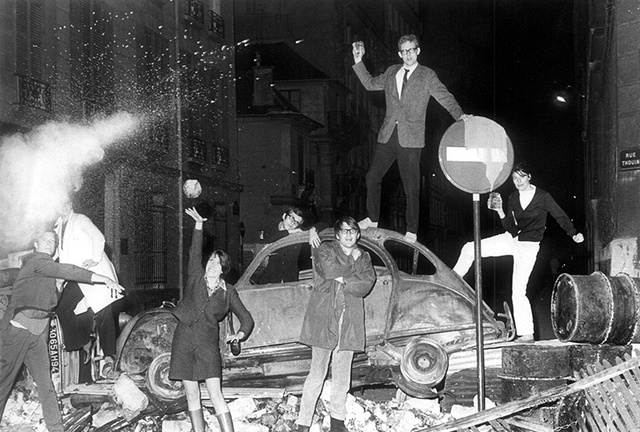 Barricade, Paris, May 1968
Barricade, Paris, May 1968
Some of today’s alt-right and neofascist provocateurs quite explicitly claim the heritage of 1960s and ’70s counter-culture and neo-avant-garde movements. More than a few observers and participants have linked US alt-right tactics to Yippie media stunts. And then there is [ex-]Breitbart editor and ex-Twitter celeb Milo -Yiannopoulos, fond of speaking of the “regressive left” and explicitly invoking punk as a historical precedent for his media stunts (might he be a Greil Marcus reader?) [4] ; while in Germany, there is the activist-publicist Götz Kubitschek, who once founded a group called Konservativ-Subversive Aktion that aimed at disturbing public appearances by old 1960s leftists – although Kubitschek is now something of an éminence grise to AfD extremist Björn Höcke. [5]
Today’s Actionism may still harken back to the voluntarist version of dialectical thinking that underpinned it in the 1960s, but it is now undeniable that the form of immaterial labor it takes is only partly human. It would be almost impossible for news about, say, Hillary or refugees to not multiply and mutate in varying degrees of factual or fake, given the path that information now takes as it flows through circuits of integrated human and machinic labor, of human trolls and bots, of campaign strategies and algorithmic voter targeting. [6]
In other words: we are dealing with a seemingly unlikely merger of Actionism and cybernetics; the latter being a “science of control or prediction of future action,” which, born during World War II and thriving in the Cold War, is intimately linked to the rise of automation and of control through real-time data processing. [7] During the 1960s, some even attempted to assimilate the new paradigm of cybernetics to dialectical materialism, and vice versa. For instance: Hartmut Bitomsky and Harun Farocki’s “Die Teilung aller Tage” (The Division of All Days, 1970), in which they are seen screening didactic short films to workers, and how Farocki’s conversations with the workers about the implications of these films were conceived both as dialectical interventions and as a form of feedback in action. [8]
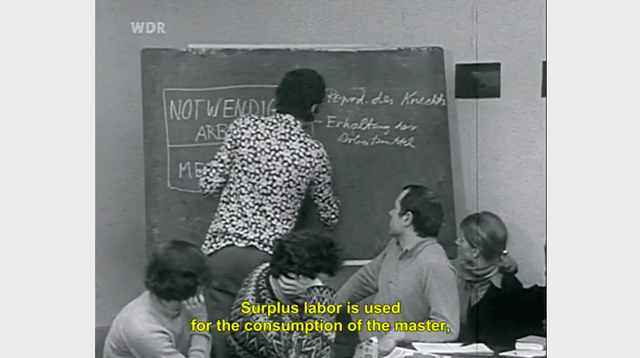 Hartmut Bitomski and Harun Farocki, "Die Teilung aller Tage," 1970, film still
Hartmut Bitomski and Harun Farocki, "Die Teilung aller Tage," 1970, film still
However, such dialectical Actionism has frequently clashed with the cybernetic paradigm. Not surprisingly, cybernetics was rejected by many leftists on grounds of being a depoliticizing discipline, given that it directly countered the approach – often favored by the left – of carrying out actions that could not be foretold or contained by the system. For the Situationists, it was clear that cybernetics would serve only to stabilize capitalism, producing a future that would be more of the same, just much worse. [9]
In opposition, the group asserted an art based in transformative action: “Our era no longer has to write poetic directives; it has to carry them out,” [10] they wrote, clarifying that the “poetry,” here, (contra informationism) had very little to do with that which is printed in chapbooks, just as no contemporary variant of the classical revolutionary movement could be taken up as a serious alternative to the prevailing organization of life. Instead, art itself was to become dialectical, historical play – not in an attempt to realize any Bolshevik party line, but as an assertion of the human capacity to make history. Today, the dépassement de l’art takes on rather different forms: in their modus operandi, figures such as Ai Weiwei or Richard Prince are structurally more similar to trolls or Twitterbots than to any artist of the past. [11] How to act and react in ways that go beyond such disastrous success remains the question of the day, of the year, of the decade.
2. Accelerations, Speculations
But now given global upper-class inbreeding and advances in genetic technology, this dream or nightmare is foundering just as much as are old-school fantasies about maintaining the purity of the “traditional” races. Land’s dark enlightenment, meanwhile, is all about re-establishing a neo-feudal, almost Tolkienian hierarchy of races, and indeed of human races becoming different species. [12]
By Land’s logic, the leftist gene-pool mixing program is the handiwork of a media and academic elite that thinks in dialectical terms, always stirring up conflict in the name of progress; creating conflict to overcome conflict in the end. “There is scarcely a fragment of the social ‘superstructure’ that has escaped dialectical reconstruction, through articulate antagonism, polarization, binary structuring, and reversal,” Land writes. “More dialectics is more politics, and more politics means ‘progress’ – or social migration to the left.” [13]
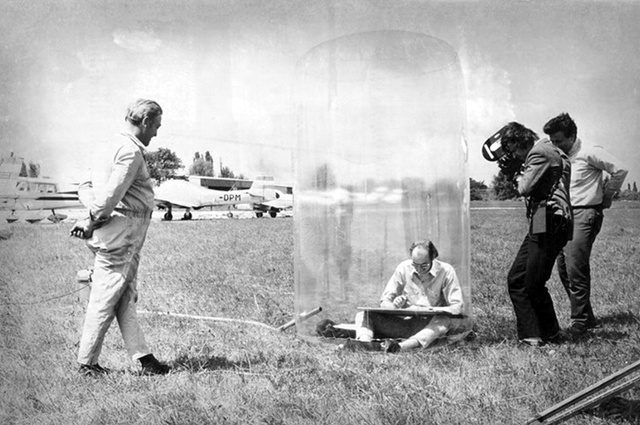 Hans Hollein, "Mobile Office," 1969
Hans Hollein, "Mobile Office," 1969
Already in his broadly influential ’90s writing, he had disparaged the dialectical, presaging the “[sidelining] of human intelligence by the coming techno sapiens.” Invoking Deleuze and Guattari, he argued that “if [machinery] is integrated immanently as cybernetic technics it redesigns all oppositionality as non-linear flow. There is no dialectic between social and technical relations, but only a machinism that dissolves society into the machines whilst deterritorializing the machines across the ruins of society, whose ‘general theory […] is a generalized theory of flux’; which is to say: cybernetics.” [14]
Rather than the normative aforementioned cybernetics of stabilization, of homeostasis, Land embraced a cybernetics of mutation, escalation, and acceleration. Today’s techno-socio-political machine is its dismal implementation: the online echo chamber is positive feedback cycle gone nuclear. However, Land’s earlier work does also continue to echo in certain leftist projects today, not least in Nick Srnicek and Alex Williams’s brand of accelerationism.
In turn, the two British theorists have allied their position with a certain strain of speculative theory simulation that attacks the left for its attachment to modernism and to the contemporary and for its failure to think with and from the future. One of the headier Landian elements in Srnicek and Williams’s speculo-accelerationist mix is the notion of hyperstition – a concept that is also the subject of Christopher Roth’s 2015 “Hyperstition,” the movie, in which talking heads hold forth on the ways in which “[hyperstitional] thinking hijacks the present-forming daring interventions into conditions of cybernetic governance that foreclose contingency.” Therein, we are told that “hyperstitions are not imaginary, they are virtual fictions situated in the chaotic unfolding of the Real”; that they “bring about their own reality” and “[materialize] the future as it leaks from beyond the threshold of comprehension.” [15]
As the rhetoric in this passage suggests, one way of looking at hyperstition – beyond all Lovecraftian gimmickry – is through the prism of a Bergsonian-Deleuzian ontology: past, present, and future do not exist in chronological succession but coexist; the actual image coexists with its virtual projection. This is discussed in the section of “Cinema 2” on the Powers of the False, wherein Deleuze argues that post-war cinema breaks with the ultimately naturalistic conventions of classical Hollywood by introducing false movement, by tapping into the powers of the false to transform, to introduce new shapes; and the final power of the false is “goodness, generosity.” [16]
There is a curious but productive tension in Deleuze’s thought, which subsumes the historical to the ontological while “denaturalizing” the latter; he insists that to side with Becoming – with difference and futurity over History – is to side with the false, with the simulacrum, with that which does not obey any model or original. In today’s post-Internet-speculative-accelerationist filter bubble, the future is at risk of becoming another annoying meme that lives from day to day and from conversation to conversation. The powers of the false have thus become dismal projections of ever-diminishing options, feebly offset by fake visions of restored “greatness” for the ex-semi-privileged.
The tipping point was marked by the 1972 Club of Rome report “The Limits to Growth.” The project employed a world model; using MIT’s computer power to calculate various scenarios, it could visualize possible futures by adjusting parameters that either sped up or slowed down the decline of the global ecosystem. The report’s final chapter addresses how sustainable equilibrium could be achieved if relevant policies were to be instituted by the mid-’70s, warning that if growth-regulating measures were to be delayed until the year 2000, equilibrium would be “no longer sustainable.” [17]
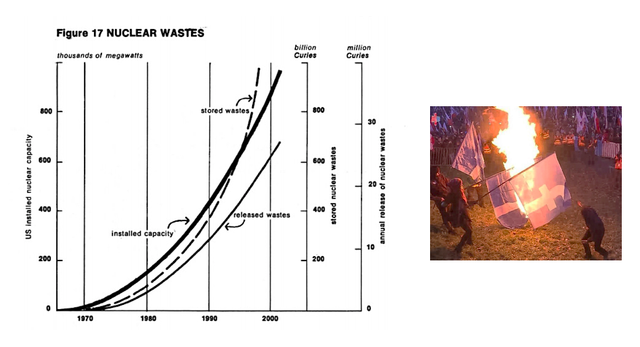 From left: graph included in "Limits of Growth" presentation to the Club of Rome, 1972; Polish nationalists burn Facebook flags.
From left: graph included in "Limits of Growth" presentation to the Club of Rome, 1972; Polish nationalists burn Facebook flags.
In 2017, so many feeble climate protocols later, the upheavals of globalization have produced a president who has tweeted (of course) that climate change is a hoax perpetrated by the Chinese. While this can be regarded as a throwback to some unspecified Dark Ages, today’s neofascisms and identitarian movements largely draw on nostalgia to cohere a base, as well as a narrative about a coming catastrophe understood to be already in progress. For the fascists, too, the future is in the process of descending upon us like a biblical plague – but here the anthropocene event is framed in terms of immigrants, Islam, and political correctness gone mad. Welcome to the Trumpocene.
Meanwhile, much neofuturism in the cultural field feeds into a dismal culture of the false – one in which artworks circulate as so much fake news. Christopher Kulendran Thomas’s 2016 “New Eelam” comes to mind, with its leap from the struggle for local autonomy by Sri Lanka’s Tamil people (a conflict that sparked the 1983–2009 Sri Lankan civil war) to a kind of cosmopolitan flat-sharing scheme with “liquid citizenship” that supposedly realizes the utopia of the elusive Tamil state. [18]
In circulation, this work has functioned like a meme in that it burrows its way into conversations precisely by both pointing to concrete (in this case, historical) referents while ultimately not making any sense. This is hyperstition as fake news. It has the same relation to Landian hyperstition that “actually existing socialism” had to the idea of communism. The one way in which the piece did work, however, was as a form of Capitalist Realism: a one-to-one reflection of the current global political-economic confusion, here set against Berlin Biennale 9, that echo chamber that reduced everything to sign value, and in which all struggle became converted into semiotic labor shoring up a certain transnational infrastructure.
There was seemingly no reason to believe, in this past summer of 2016, that history would come back with a vengeance – and that it would come back precisely from the future that the snake oil salesmen of post-speculo-accelerationism kept invoking.
Cue Armen Avanessian speaking with Suhail Malik for DIS Magazine in the lead up to bb9: “We no longer have a linear time, in the sense of the past being followed by the present and then the future. It’s rather the other way around: the future happens before the present, time arrives from the future.” [19] In his mythifying register, the author here gets it exactly right. Future tipping points cast ripples in the present. Scientific projections mingle with utopian and eschatological imaginaries. The belief that “global warming is a hoax” is an “alternative fact” necessary for the continuation of relentless extractivism that will accelerate the very process that is being denied. Racist dog whistles about a time when America used to be “great” barely cover up that new hierarchies are being created on the basis of – but not always identical to – the old.
And this is precisely where Nick Land is a good guide to the real ideological and political drift. The ongoing attempts by certain speculo-accelerationists to normalize latter-day Land are a chilling reminder of just how entangled specific nodes of the General Intellect – including some with art-world street cred – are in the rise of neofascism. And indeed, Land’s penchant for the extreme and symptomatic can be illuminating.
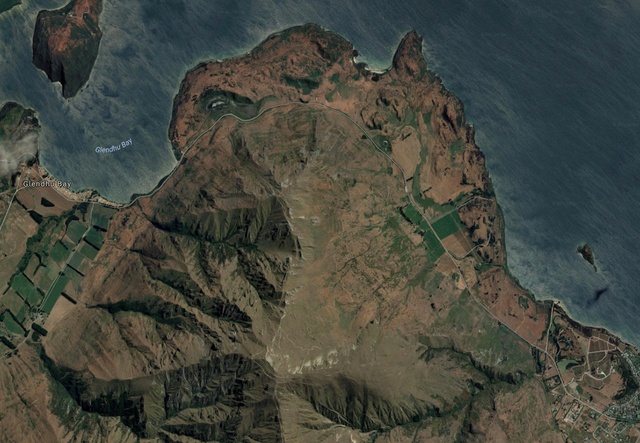 View picturing Peter Thiel's coastline estate on Glendhu Bay, Lake Wanaka, New Zealand
View picturing Peter Thiel's coastline estate on Glendhu Bay, Lake Wanaka, New Zealand
For instance, its resonance with Peter Thiel’s statement that freedom and democracy are incompatible; the Silicon Valley and Trump campaign investor having expressed concern about the chances for Randian libertarianism in a world in which “welfare beneficiaries” and women have voting rights. Thiel has also financed plans for artificial island cities for those members of the elite who would give up American citizenship for “seasteading” tax havens – Thiel’s New Eelam. [20]
Meanwhile, Landian overtones can also be discerned in responses to a new wave of automation that is making ever more types of human labor superfluous; especially in left-accelerationism’s insistence that full automation will finally be the dialectical tipping point, necessitating an end to labor and, in turn, broad acceptance of universal basic income. The latter, of course, is also a popular notion in Silicon Valley, lest consumption be impeded in a post-work society.
It is, paradoxically, the relentless linearity of certain historical developments – automation and desertification, rising unemployment and rising sea levels – that generates unpredictable (i.e., competing, interfering) forms of feedback in the present. And yet these invariably come guised in historical-ideological imaginaries. As the number of potential futures has dwindled and the future as the virtual has been actualized before its time, the present future takes the form of a Darwinist Verteilungskampf (survival of the fittest).
We are in a moment where a large number of progressive and inclusive social imaginaries in the global melee are losing out to neofascist enclosures. In such a situation, questions over the agency of artistic actions, over the effects of protest and organizing of cultural workers, need to be assessed without either delusions of grandeur or self-flagellating declarations of impotence.
3. Forms and Fictions
Take, for example, Sean Snyder’s recent contribution to Grey Room’s post-election dossier: an email “report of suspicious activity” to the US Department of Homeland Security in which he sketched a paranoid world of signs and anticipations, describing (either as he, the artist, or his email persona) how a man on the street in Washington, DC had “a red, white and blue Slurpee knocked out of his hands by an assailant,” and how this Slurpee splattered on the asphalt in a way that looked “similar to [Pollock’s] Lavender Mist exhibited at the Smithsonian National Gallery of Art.” “The apparition of the CIA-supported artist’s painting is maybe a prediction of imminent crisis,” Snyder’s email warns. With his cryptic references to a “suspended exhibition on the onslaught of the Cold War, Trompe l’œil phenomenon, and the Art of Deception,” the writer seems intent on having himself put on a watchlist. [21]
The Grey Room dossier – also containing more discursive texts by, for example, Zachary Formwalt, Fred Lonidier, Simon Leung, and Martha Rosler – is itself a formal and social arrangement, a constellation running the gamut from the marvelously solipsistic to the explicitly political (with a few examples of utter idiocy thrown in for good measure). There is, in today’s art, a critical struggle for form that also includes forms of action, forms of resistance, self-organization, self-constitution. Artistic activism often takes the form of collective institutional critique (e.g., Occupy Museums, Gulf Labor). Such critique is aimed at pre-given structures that (via systemic exploitation and violence) shape practice and subjectivity. Organize yourselves before others do it for you.
This kind of action recently took the shape of an art strike protesting Trump’s inauguration; the pussy-grabber is today’s Vietnam. [22] Here re-actualized from its virtual state in the archive of unrealized futures, the art strike (standing, for some, as the artistic branch of the “general strike,”) wore its meaning-producing immaterial labor on its sleeves, its duration limited to inauguration day. While problematic, such gestures nonetheless counter normalization and business-as-usual in the place of work, and they produce at least an intimation – an image, a simulacrum – of different meanings and alternative forms of exchange and collaboration in a competitive field that is all about distinction. [23]
In the current situation, symbolic battles over (bad) “folk politics” versus (good and grand) accelerationist notions are unproductive as schematic oppositions between (merely) critical and (properly) speculative thought. Theoretical as well as practical organization is needed; prefigurative self-constitution as well as written and visual forms that resist immediate implementation.
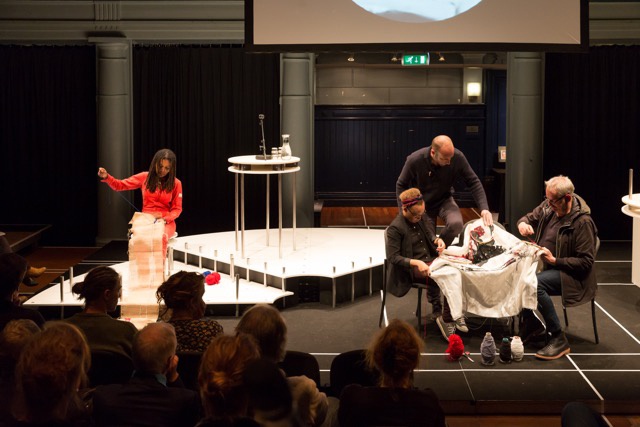 Lara Staal and Jonas Staal, "Congress of Utopia," 2016
Lara Staal and Jonas Staal, "Congress of Utopia," 2016
In this respect, it was apposite that Jonas and Lara Staal’s Congress of Utopia, which took place shortly before the US election this past fall, engaged with the utopian tradition precisely in its oscillation between literary imagination and political program, through grassroots organization and party-building and artistic performance. Taking place in a set based on Constant’s 1959 “Ambiance de départ” model, the Congress created a disjunctive synthesis of imaginary vistas and mundane, relentless practice.
As in the 1960s, the current political moment places us in a situation in which “new forms of action” and new organizational forms seem at once critically necessary and elusive. “Der Sinn der Organisation ist ihr Scheitern” (The Point of the Organization Is its Failure) is the title of a book collecting documents of the ’60s Subversive Aktion group, co-edited by onetime member Frank Böckelmann (who these days publishes screeds against the migrant hordes and against the globalist mixing of cultures). [24] In some respects, the flippancy of this title appears utterly obsolete: it is clear that – in Europe as in the US – the coming years will be marked by struggles for basic human rights, and failure would be truly disastrous rather than a fun experiment. However, what constitutes success or failure is not necessarily obvious in the vicinity of art.
Imitating successful alt-right tactics of media activism can be tempting, and sometimes necessary, but in some ways the alt-right campaigns are themselves perverted versions of the tactical media practices that emerged in the 1990s; another genealogical twist that was recently explored in a group show titled “As If,” which opened on the day of Trump’s inauguration and combined historical “tactical media” activism with recent projects, such as Ian Alan Paul’s Guantamo Bay Museum of Art and History. [25]
While the merits of historical cases – such as the Yes Men or the net-art duo Ubermorgen conning the mainstream media – would have to be reassessed in light of recent developments, the exhibition’s emphasis on activist media art deploying forms of fiction and fictional forms in a post-truth context was highly to the point. One might think here of another semi-intentional tactical media action that should be discussed in this context: the moment when Glenn Beck, in 2010, spoke in tongues against the Invisible Committee’s “evil” “Coming Insurrection.” It is debatable whether this did more for the Invisible Committee (sales skyrocketed) or for strengthening the Fox News narrative, but this is part of the point: the event was an unpredictable form of feedback that, triggered by the Invisible Committee’s carefully crafted persona, effectively played into Beck’s conspiracism as much as it did the book’s thesis.
All too often, leftist intellectual labor is conceived along the lines of a rather impoverished notion of Enlightenment: to fact-check right-wing lies, to reveal the truth. Of course outright lies need to be countered, but this reactive position, this role of always playing the cop, hardly taps the left’s full potential. The neofascist right, meanwhile, prioritizes the labor of ideology: they are good artificers and take this work seriously. On the progressive side, there have been moments of narrative building; the strength of the 99% meme was that it allowed people to make sense of their social reality in ways other than fascist retrenchment.
It was factually – statistically – correct, but of course the assertion that we are the 99% (owning less than the top 1%) was also a piece of trickery; as with every collective assertion of this sort, it was a performative rather than descriptive use of language. It created a new collective persona on a grander scale than the Invisible Committee. Yet different scales, from slurpee-spotting to organization building, are to be exploited simultaneously; no single tactic is the magical answer to all our problems. Now that the false has been actualized in a dismal new reality of alternative facts, one project could be precisely to falsify the fake: to introduce fictional forms and aesthetic falsehoods that provide different feedback and allow other futures to manifest themselves.
Sven Lütticken teaches art history at the Vrije Universiteit Amsterdam and theory at the Dutch Art Institute. His most recent book, "Cultural Revolution: Aesthetic Practice After Autonomy" was published this year by Sternberg Press.
This article appears in print in the March 2017 issue (#105) of Texte zur Kunst. https://www.textezurkunst.de/105/
Notes
| [1] | Tolkien fan art |
| [2] | Sven Lütticken, “Who Makes the Nazis?,” http://www.e-flux.com/journal/76/69408/who-makes-the-nazis/. |
| [3] | See also Evgeny Morozov, “Fake News sind ein Symptom des digitalen Kapitalismus,” in: Süddeutsche Zeitung, January 19, 2017. |
| [4] | See http://www.breitbart.com/milo/2016/09/22/milo-louisiana-state-being-a-trump-supporter-is-the-new-punk/; Yiannopoulos posted a link to this article on Facebook with the comment “We are the counterculture now.” |
| [5] | Kubitschek was present during Höcke’s notorious speech in which he characterized the Holocaust Memorial in Berlin as a disgraceful monument of German shame; he later provided an apology at http://sezession.de/56961/. |
| [6] | On the mythmaking surrounding the role of the data mining outfit Cambridge Analytica in Trump’s victory, see http://littleatoms.com/news-science/donald-trump-didnt-win-election-through-facebook. |
| [7] | Orit Hapern’s definition in Beautiful Data: A History of Vision and Reason since 1945, Durham/London 2014, p. 41. |
| [8] | See Tom Holert’s text “On ‘Die Teilung aller Tage’ (1970) and ‘Eine Sache, die sich versteht (15x)’ (1971),” distributed in his exhibition “Learning Laboratories” at BAK, Utrecht, the Netherlands, 2016f. |
| [9] | Hito Steyerl, “If You Don’t Have Bread, Eat Art!: Contemporary Art and Derivative Fascisms,” http://www.e-flux.com/journal/76/69732/if-you-don-t-have-bread-eat-art-contemporary-art-and-derivative-fascisms/. |
| [10] | SI, “All the King’s Men,” in: Internationale Situationniste, 8, 1963, transl. by Ken Knabb, http://www.bopsecrets.org/SI/8.kingsmen.htm. |
| [11] | Prince makes this explicit in the disturbing comments he adds to his “New Portraits”; for an impressively generous interpretation, see Jerry Saltz, “Richard Prince’s Instagram Paintings Are Genius Trolling,” http://www.vulture.com/2014/09/richard-prince-instagram-pervert-troll-genius.html. |
| [12] | Nick Land, “Hyper-Racism,” http://www.xenosystems.net/hyper-racism/. |
| [13] | Nick Land, “The Dark Enlightenment, Part 1,” http://www.thedarkenlightenment.com/the-dark-enlightenment-by-nick-land/. |
| [14] | Nick Land, “Circuitries” (1992), in: Robin Mackay/Armen Avanessian (eds.), #Accelerate: The Accelerationist Reader, Falmouth/Berlin 2014, pp. 256f. |
| [15] | From the film’s blurb in DIS Magazine, http://dismagazine.com/blog/77351/hyperstition-truth-is-science-is-fiction/. |
| [16] | Gilles Deleuze, Cinema 2: The Time-Image, trans. Hugh Tomlinson/Robert Galeta, London 1989, p. 147. |
| [17] | Donella H. Meadows et al., The Limits to Growth: A Report for the Club of Rome’s Project on the Predicament of Mankind, second edition, New York 1972, p. 169. See also Pedro Neves Marques, “Whose Limits? The Generational Continuum (1972–2015),” in: Maria Hlavajova/Simon Sheikh (eds.), Former West: Art and the Contemporary after 1989, Cambridge, Mass/London 2017, pp. 369–77. |
| [18] | See also Anselm Franke/Ana Teixeira Pinto, “Post-Political, Post-Critical, Post-Internet: Why Can’t Leftists Be More Like Fascists?,” http://onlineopen.org/post-political-post-critical-post-internet. |
| [19] | Armen Avanessian/Suhail Malik, “The Time-Complex. Postcontemporary,” http://dismagazine.com/discussion/81924/the-time-complex-postcontemporary/. |
| [20] | JK. Trotter, “What Does Peter Thiel Want?,” http://gawker.com/what-does-peter-thiel-want-1784039918; for Land on Thiel, see part 1 of “The Dark Enlightenment.” |
| [21] | Sean Snyder, “Trompe-L’Œil,” in: Grey Room Post-Election Artists Dossier, supplement to Grey Room, 65, Fall 2016, unpaginated. |
| [22] | One of the more visible but also more problematic actions was the Dear Ivanka initiative, in which artists who have had their work collected by Trump’s daughter and her husband Jared Kushner spoke out about the (alleged) disconnect between the values of their art and those of America’s new First Family. While Dear Ivanka employed the basic institutional critique tactic of revealing the art world’s political and economic entanglements, it came across as a feeble form of consumer feedback (or rather: producer feedback to the consumer) by artists who gave this matter little thought before it was too late. |
| [23] | See also Coco Fusco, “Why an Art Strike? Why Now?,” http://hyperallergic.com/350529/why-an-art-strike-why-now/. |
| [24] | Frank Böckelmann/Herbert Nagel, “Nachwort” (2001), in: Subversive Aktion. Der Sinn der Organisation ist ihr Scheitern, Frankfurt/M. 2002. |
| [25] | See http://framerframed.nl/en/exposities/expositie-as-if-the-media-artist-as-trickster/. |

